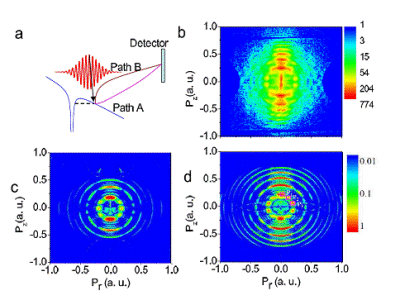Time:2014-03-19ClickTimes:
The observation of above threshold ionization as a benchmark experiment has
significantly motivated the progress of strong-field physics. Above threshold
ionization is one of the most important processes in strong-field community. The
researchers at School of Physics, Peking University have developed an intuitive
quantum-trajectory Monte Carlo (QTMC) model encoded with Feynman's path-integral
approach based on the tunneling theory, in which the Coulomb effect on electron
trajectories and interference patterns are fully considered. They achieved a
good agreement with the measured photoelectron angular distributions of atoms
for above threshold ionization. The QTMC theory sheds light on the role of ionic
potential on photoelectron angular distributions along the longitudinal and
transverse direction with respect to the laser polarization, allowing to unravel
the classical coordinates (i.e., tunneling phase and initial momentum) at the
tunnel exit for all of photoelectrons of photoelectron angular distributions.
They have studied the classical-quantum correspondence and build a bridge
between the above threshold ionization and the tunneling theory. The paper was
published on Physical Review Letters [Min Li et al., Phys. Rev. Lett. 112,
113002(2014)].

|
Fig. 1 (a) Illustration of the QTMC model. The subsequent electron
motion in the combined laser field and Coulomb potential after the
tunnel exit is governed by the Newtonian equations. Electrons could
follow the different paths, i.e., path A and path B, and have the same
final momenta on detector and will interfere with each other. (b) The
experimental PAD of Xe at the intensity of 0.75×1014 W/cm2 (795 nm). (c)
The simulated PAD of Xe at the intensity of 0.5×1014 W/cm2 (795 nm). (d)
The simulated PAD of Xe at the intensity of 0.75×1014 W/cm2 (795 nm).
|
